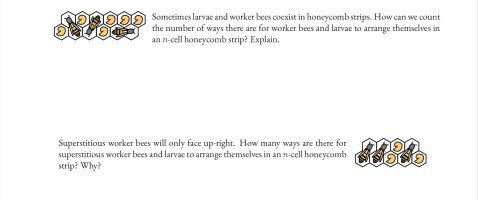There are two questions I need some help with. They both involve a ‘honeycomb strip’ (which is just a hexagonal tessellation of two rows), ‘worker bees’ (which take up two hexagons), and larvae (which take up one hexagon).
How can we count the number of ways there are for worker bees and larvae to arrange themselves in an n-cell honeycomb strip? Explain.
Superstitious worker bees will only face up-right. How many ways are there for superstitious worker bees and larvae to arrange themselves in an n-cell honeycomb strip? Why?
There are two questions I need some help with. They both involve a ‘honeycomb strip’ (which is just a hexagonal tessellation of two rows), ‘worker bees’ (which take up two hexagons), and larvae (which take up one hexagon).
This kind of reminded me of that famous domino tiling problem, so it appears that we need to use induction. I tried to build to recurrences: when n = 2k (An) and when n = 2k+1 (Bn). And I got something like An = Bn-1 + An-1 + An-2 + Bn-2 , and Bn = An + Bn-1 + An-1 + Bn-2 , but apparently that’s not right
Thank you to any answers in advanced!
How can we count the number of ways there are for worker bees and larvae to arrange themselves in an n-cell honeycomb strip? Explain.
Superstitious worker bees will only face up-right. How many ways are there for superstitious worker bees and larvae to arrange themselves in an n-cell honeycomb strip? Why?
There are two questions I need some help with. They both involve a ‘honeycomb strip’ (which is just a hexagonal tessellation of two rows), ‘worker bees’ (which take up two hexagons), and larvae (which take up one hexagon).
- How can we count the number of ways there are for worker bees and larvae to arrange themselves in an n-cell honeycomb strip? Explain.
- Superstitious worker bees will only face up-right. How many ways are there for superstitious worker bees and larvae to arrange themselves in an n-cell honeycomb strip? Why?
- attached is a screenshot of the question for clarity

This kind of reminded me of that famous domino tiling problem, so it appears that we need to use induction. I tried to build to recurrences: when n = 2k (An) and when n = 2k+1 (Bn). And I got something like An = Bn-1 + An-1 + An-2 + Bn-2 , and Bn = An + Bn-1 + An-1 + Bn-2 , but apparently that’s not right
Thank you to any answers in advanced!
